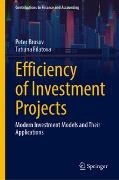Read more
Existing investment models fail to correctly assess the efficiency of investments. This happens due to both the lack of self-consistent models based on first principles and the inability to correctly assess the discount rate. This book describes innovative investment models tested in practice. The authors modify these models for real implementation conditions, including frequent payments of income tax and interest on debt at the end of periods and as advance payments, and variable payments. The book examines how these types of payments influence the efficiency of investment projects. It considers the efficiency of an investment project from two perspectives: the owners of equity and debt, and only the equity. The latest versions of two main theories of capital structure (Brusov–Filatova–Orekhova (BFO) and Modigliani–Miller (MM)) allow for the correct assessment of the discount rate when evaluating the efficiency of investment projects (both long-term and of arbitrary duration). The book also describes the practical application of the created investment models and develops a new methodology for rating investment projects.
List of contents
Introduction.- Evaluation of the efficiency of investment projects.- Capital Structure.- Capital Structure: Modigliani–Miller Theory.- The Modigliani–Miller theory with arbitrary frequency of payment of tax on profit.- Modification of the Modigliani–Miller Theory for the Case of Advance Tax on Profit Payments.- How Frequently Should Companies Pay Tax on Profit.- Generalization of the Modigliani–Miller Theory for the Case of Variable Profit.- Modern Theory of Capital Cost and Capital Structure: Brusov–Filatova–Orekhova Theory (BFO Theory).- The Generalization of the Brusov–Filatova–Orekhova Theory for the Case of Payments of Tax on Profit with Arbitrary Frequency.- Benefits of Advance Payments of Tax on Profit: Consideration within Brusov–Filatova–Orekhova (BFO) Theory.- Influence of Method and Frequency of Profit Tax Payments on Company Fi-nancial Indicators.- Generalization of the Brusov–Filatova–Orekhova Theory for the Case of Variable Income.- Inflation in Brusov–Filatova–Orekhova theory and in its perpetuity limit – Modigliani – Miller theory.- Investment Models with Debt Repayment at the End of the Project and Their Application.- Investment Models with Uniform Debt Repayment and Their Application.- Innovative Investment Models with Frequent Payments of Tax on Income and of Interest on Debt.- Investment Models with Advance Frequent Payments of Tax on Profit and of Interest on Debt.- Portfolio of Securities.- Investing in a Bond Portfolio.- Application of the Modigliani–Miller Theory in Rating Methodology.- Application of the Modigliani–Miller Theory, Modified For the Case of Advance Payments of Tax on Profit, in Rating Methodologies.- A New Approach to Project Ratings.- Rating methodology: new look and new horizons.- Ratings of the Investment Projects of Arbitrary Durations: New Methodology.- Ratings of Investment Projects of Arbitrary Duration with a Uniform Debt Repayment: a new approach.- Whether it is possible to increase taxing and con-serve a good investment climate in the country?.- Whether it is possible to increase of the in-vestment efficiency, increasing tax on profit rate? An abnormal influence of growth of tax on profit rate on the efficiency of the investment.- The analysis of the exploration of efficien-cy of investment projects of arbitrary du-ration (within Brusov–Filatova–Orekhova theory).- Optimizing the Investment Structure of the Telecommunication Sector Company.- The Role of the Central Bank and Commercial Banks in Creating and Maintaining of a Favorable Investment Climate in the Country.- Conclusions.
About the author
Peter Brusov is professor at the Financial University under the Government of the Russian Federation in Moscow (Russia). He is an expert in financial management, corporate finance, investments, ratings, taxation, business valuation. He is a co-author of the famous Brusov-Filatova-Orekhova theory, which replaced the well-known Modigliani-Miller theory, created by Nobel Prize Laureates. As well he is a co-author of the CAPM 2.0 model, which generalized the famous CAPM model for accounting the financial risk along with business risk. Peter Brusov is the author of the qualitatively new approach to business valuation. He has been a visiting Professor of Northwestern University (USA), Cornell University (USA), Osaka City University (Japan) and National Chung Cheng University (Taiwan) among other places. He is the author of over 550 research publications including nine monographs, numerous textbooks and articles.
Tatiana Filatova is professor at the Financial University under the Government of the Russian Federation in Moscow (Russia). She is an expert in financial management, corporate finance, investments, ratings, taxation, business valuation. Tatiana Filatova is a co-author of the famous Brusov-Filatova-Orekhova theory, which replaced the well-known Modigliani-Miller theory, created by Nobel Prize Laureates. As well she is a co-author of the CAPM 2.0 model, which generalized the famous CAPM model for accounting the financial risk along with business risk. Tatiana Filatova is the author of the qualitatively new approach to business valuation. In the past 20 years, she has been Dean of the faculties of financial management, management, state and municipal government at the Financial University. Tatiana Filatova is the author of over 300 research publications including eight monographs, numerous textbooks and articles.
Summary
Existing investment models fail to correctly assess the efficiency of investments. This happens due to both the lack of self-consistent models based on first principles and the inability to correctly assess the discount rate. This book describes innovative investment models tested in practice. The authors modify these models for real implementation conditions, including frequent payments of income tax and interest on debt at the end of periods and as advance payments, and variable payments. The book examines how these types of payments influence the efficiency of investment projects. It considers the efficiency of an investment project from two perspectives: the owners of equity and debt, and only the equity. The latest versions of two main theories of capital structure (Brusov–Filatova–Orekhova (BFO) and Modigliani–Miller (MM)) allow for the correct assessment of the discount rate when evaluating the efficiency of investment projects (both long-term and of arbitrary duration). The book also describes the practical application of the created investment models and develops a new methodology for rating investment projects.

